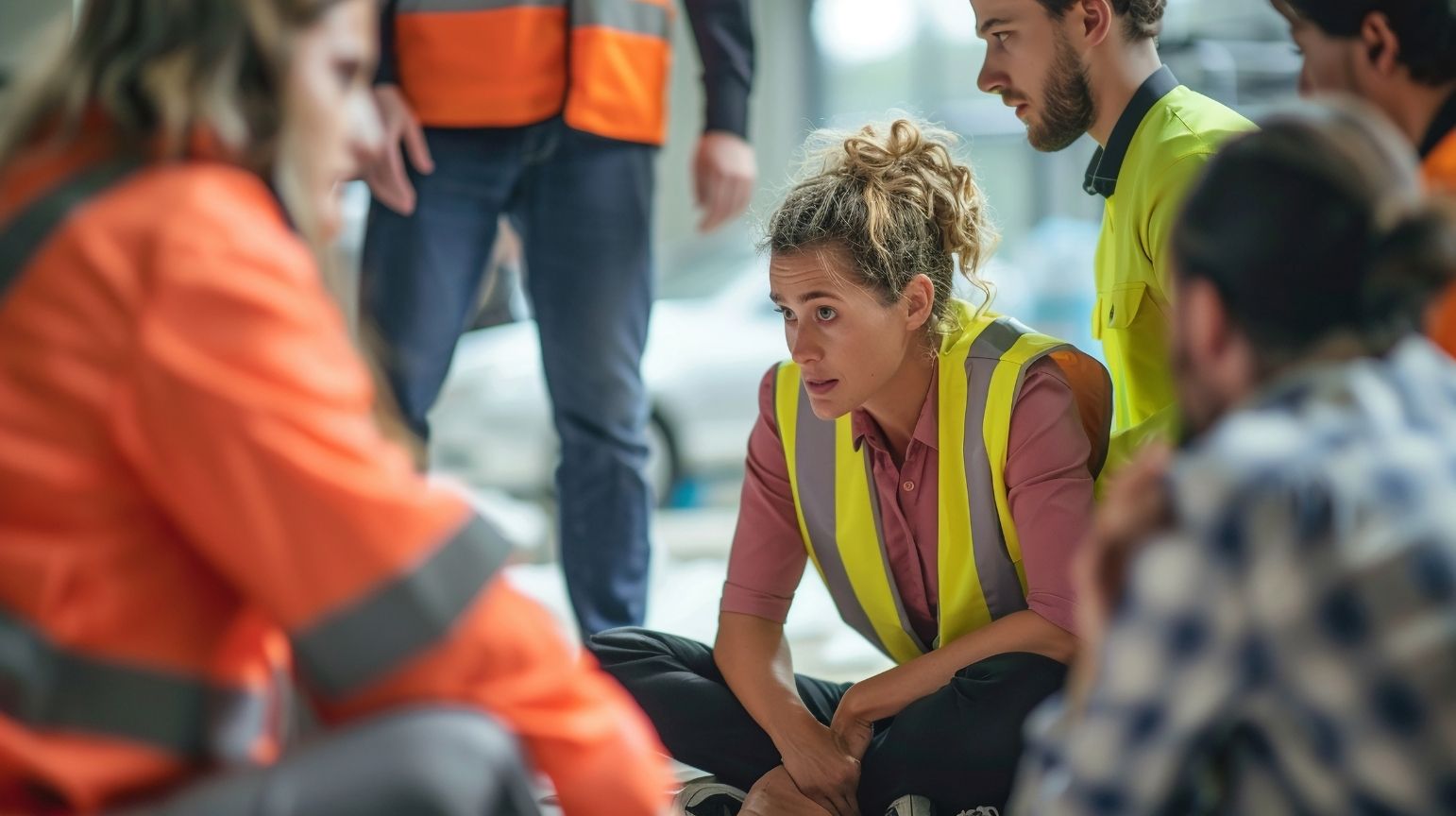Introduction
Site re-vegetation refers to the process of restoring plant life to an area after it has been disturbed or degraded. This step is crucial after a lease clean-up, as it aids in rejuvenating the land for future use. It contributes to ecosystem health and enhances the environment in various ways. Notably, re-vegetation improves soil health, restores habitats for wildlife, and increases biodiversity.
By carefully engaging in re-vegetation, you can reclaim and revitalize the land, ensuring it serves future generations. Throughout this guide, we will discuss essential steps for effective site re-vegetation. We’ll cover everything from assessing the site to selecting the right plants and monitoring growth.
Through this process, you will learn how proper re-vegetation not only benefits the environment but also contributes to the aesthetic appeal of the land. So, let’s dive into how you can successfully revitalize your space and promote a healthier ecosystem.
Understanding Lease Clean Up
What is Lease Clean Up?
Lease clean-up refers to the thorough remediation process of a property before or after a lease period. It’s essential for returning the land to its natural state or preparing it for new development. This task typically involves various activities, such as removing debris, cleaning up hazardous materials, and restoring the landscape. A proper lease clean-up ensures that the site is safe and ready for the next steps in land management.
Why is Lease Clean Up Necessary?
Lease clean-up plays a crucial role in land restoration and environmental health. First and foremost, it addresses potential environmental hazards. For instance, leftover chemicals or waste materials can harm local wildlife and affect soil quality. By cleaning up, you reduce these risks significantly.
Additionally, regulatory compliance is another critical factor. Many regions require clean-up before a property can be legally reused. Failing to meet these standards can lead to fines and prolonged delays in future development.
Lease clean-up also boosts aesthetic appeal. A cleared and well-maintained site is more inviting and can increase property value. More importantly, it sets the stage for successful re-vegetation, which enhances overall biodiversity and restores natural habitats. Without a thorough clean-up, any re-vegetation efforts may be compromised.
In summary, lease clean-up serves multiple purposes. It safeguards the environment, ensures compliance, and prepares the site for a thriving ecosystem. By prioritizing this step, we lay the foundation for effective site re-vegetation, creating a greener and healthier landscape for all.
Step 1: Site Assessment
Site assessment is a crucial step in effective re-vegetation. It lays the groundwork for a successful restoration project. Without understanding the site’s unique characteristics, your re-vegetation efforts may fall short. Let’s dive into why site assessment matters and what you should evaluate.
Importance of Site Assessment
A thorough site assessment helps you identify the current conditions and needs of the area. Here are some key reasons why it matters:
- Identify Existing Challenges: Assess conditions such as soil contamination and poor drainage.
- Tailored Strategies: Knowing these factors allows you to adjust your re-vegetation strategy.
- Biodiversity Enhancement: Understand the plants and wildlife present, encouraging biodiversity.
By understanding your site, you can make informed decisions that support successful and sustainable re-vegetation efforts.
Key Elements to Evaluate
When conducting a site assessment, focus on these essential elements:
Soil Quality
Start by examining the soil. Check its pH and nutrient levels to ensure plants will thrive. Also, test for contaminants, especially in areas with industrial use. Healthy soil is the foundation for vibrant plant growth.Existing Flora and Fauna
Identify any plants or animals already inhabiting the site. Knowing which species are present can guide your plant choices. Incorporating native plants enhances wildlife habitats and strengthens the local ecosystem.Drainage Patterns and Topography
Observe how water flows across the land. Good drainage can prevent waterlogging, which may harm new plantings. Topography, including slopes and dips, affects your planting layout. This information is vital for effective water management planning.
Step 2: Site Preparation
After completing the lease clean-up, the next critical phase is site preparation. This step ensures that your land is primed for successful re-vegetation. It involves several essential activities, including clearing debris, grading the ground, and improving soil quality. Each of these elements plays a vital role in fostering a healthy environment for native plants to thrive.
Clearing and Grading
Minimizing soil disturbance is crucial during the clearing and grading process. Excessive disturbance can harm beneficial soil organisms and disrupt existing ecosystems. Here’s how to properly prepare your site:
Remove Debris: Start by clearing the area of any leftover debris. This includes rocks, trash, and remnants from any previous structures. Opt for manual removal where possible to limit soil disruption.
Grade Thoughtfully: When grading, aim for a gentle slope rather than a flat surface. This approach helps with drainage and prevents water from pooling in one area.
Use Care with Heavy Machinery: If heavy machinery is necessary, choose equipment that minimizes soil compaction. Overly compacted soil can hinder plant roots from spreading and accessing necessary nutrients.
- Plan for Erosion Control: After grading, implement erosion control measures. This might include silt fencing or temporary cover crops to protect the soil until planting begins.
By following these practices, you create a more conducive environment for new plants, setting the stage for successful re-vegetation.
Soil Improvement
Next, focus on improving soil quality to support your future plantings. Healthy soil provides the foundation for a thriving ecosystem. Here are techniques to consider:
Conduct Soil Testing: Before applying any amendments, conduct tests to analyze pH levels, nutrient content, and potential contaminants. This information helps tailor your amendments to meet the specific needs of the soil.
Add Organic Matter: Incorporate organic materials, such as compost or well-rotted manure, into the topsoil. This enriches the soil and enhances its structure. Organic matter increases nutrient availability and improves moisture retention.
Balance Nutrients: If your soil tests indicate deficiencies in key nutrients, consider adding fertilizers or specific minerals. Aim for naturally derived options to promote soil health over synthetic alternatives.
- Inoculate Soil: Consider using beneficial microorganisms that can improve soil health. Mycorrhizal fungi, for instance, helps plants absorb water and nutrients more effectively.
By focusing on soil improvement, you create a nurturing base for your native plants. Healthy soil not only supports immediate growth but also fosters long-term ecological balance as plants take root and thrive in their new environment. Following these preparation steps sets you on the right path for a successful re-vegetation project.
Step 3: Selecting Native Plants
Importance of Native Plants
Selecting native plants is a crucial step in effective site re-vegetation. These species have evolved to thrive in local conditions. They adapt more easily to the existing soil and climate, making them more resilient. By using native plants, you not only enhance biodiversity but also restore the natural balance of the ecosystem. Moreover, native plants typically require less water and fewer chemical inputs compared to non-native varieties. This results in a healthier environment and promotes sustainability. When you choose native species, you foster a deeper connection with the local ecosystem.
How to Choose the Right Plants
To pick the best native plants, start by reviewing your site assessment. Focus on the specific conditions of your area. Here are some helpful tips:
Assess Climate: Identify your local climate zone. Various native plants thrive in different climates, so it’s essential to know what works best in your region.
Consider Soil Type: Examine the soil quality and drainage patterns. Some plants prefer sandy, well-drained soils, while others thrive in heavy clay. Choosing species compatible with your soil type enhances their chances of survival.
Evaluate Existing Flora: Look around your site for any thriving native plants. These existing species can offer clues about what else might work in your re-vegetation efforts.
Consult Local Experts: Reach out to local nurseries or environmental groups. They can provide insights and recommendations tailored to your area.
Think About Wildlife: Select plants that support local wildlife. Consider species that provide food and habitat for pollinators, birds, and other creatures. This choice not only helps wildlife but also enhances the ecological balance of your site.
- Choosing the right native plants may require some research, but it’s a rewarding endeavor. By taking the time to understand your site and selecting the proper species, you’ll set the stage for a vibrant and resilient ecosystem.
Step 4: Planning the Layout
Designing an effective planting layout is essential for successful re-vegetation. A well-thought-out plan enhances plant health and ecosystem stability. In this section, we’ll explore how to create that layout to ensure your efforts yield the best results.
Designing the Planting Plan
A good planting plan considers various factors. First, group plants based on their water needs. For example, place water-loving species together and those that require drier conditions in well-drained areas. This strategy simplifies watering and reduces competition.
Next, plan for growth. Consider the size each plant will reach at maturity. Tall plants should go at the back of a border, while shorter varieties belong in the front. This arrangement prevents shading of smaller plants and allows each species to thrive.
Finally, think about seasonal succession. Choose plants that bloom or provide visual interest at different times. This diversity creates a vibrant landscape throughout the year. It also supports various pollinators and local wildlife, promoting biodiversity.
Creating Diversity
Plant diversity is crucial for long-term success. A mix of species can withstand pests and diseases better than a monoculture. It creates a balanced ecosystem that thrives on natural interactions.
Begin by incorporating a mix of grass, shrubs, and trees. Focus on native varieties suited to your region. These plants are more resilient and require less maintenance. They are also better at providing habitat for local wildlife.
Additionally, consider different growth habits. Introduce groundcovers alongside taller plants. This will reduce soil erosion and suppress weeds. By creating multiple layers, you enhance both visual appeal and ecological function.
In summary, a carefully planned layout fosters a thriving environment. By grouping plants wisely and building diversity, you prepare your site for effective re-vegetation. Remember, the success of your project relies on more than just planting. It starts with a solid design.
Step 5: Planting Techniques
Re-vegetation takes time and careful planning, but now you’ve arrived at one of the most exciting steps: planting! This part is where all your preparation pays off. Follow these key guidelines for the best results.
Timing is Key
First, let’s talk about timing. When you plant your native species significantly impacts their survival. The best times to plant usually fall in early spring or late fall. This timing allows roots to establish before intense summer heat or harsh winter. Observe local weather patterns and adjust accordingly for optimal results.
Planting Methods
Choosing the right planting method can also enhance your chances of success. Two primary methods stand out: direct seeding and transplanting seedlings.
Direct Seeding
Direct seeding involves sowing seeds directly into the prepared soil. This method works well for many native plants. It mimics natural processes, allowing seeds to interact with the soil and rain as they would in the wild. If you opt for this method, ensure you:
- Scatter seeds evenly.
- Cover them with a thin layer of soil.
- Keep the area moist until germination.
Transplanting Seedlings
Transplanting involves moving seedlings from a nursery or your home garden directly into the site. This method can lead to quicker results since you start with established plants. When transplanting, follow these tips for success:
- Dig a hole twice the width of the root ball for easy growth.
- Ensure the plant is at the same depth as it was in the nursery.
- Water generously after planting, helping the roots settle in.
Best Practices for Enhanced Survival Rates
Regardless of the method you choose, following best practices can improve survival rates significantly:
Spacing: Ensure plants have enough space for growth. This helps with airflow and reduces competition for nutrients.
Soil Contact: Make sure roots are in good contact with the soil. Air pockets can cause stress and hinder growth.
Watering: Immediately after planting, give each plant thorough watering. This helps them settle and reduces transplant shock.
- Protection: Consider using protective barriers, like mulch or fencing, to shield young plants from pests and elements.
By paying attention to timing and employing the right planting methods, you set the stage for a thriving re-vegetation project. Your efforts now will lead to healthy ecosystems tomorrow. Happy planting!
Step 6: Post-Planting Care
After planting, ensuring your plants thrive is crucial. Proper post-planting care significantly boosts their chances of survival. Let’s explore two key aspects: watering and mulching.
Watering and Irrigation
Consistent watering is vital. Newly planted native species need moisture to establish their roots. For the first few weeks, check your plants daily. Early morning or late afternoon is the best time to water. This prevents evaporation and gives plants enough time to soak up moisture.
Consider different irrigation options. Drip irrigation systems provide targeted moisture. They minimize water waste and keep the soil around roots consistently damp. Rainwater collection systems also offer a sustainable way to water. Collecting rainwater not only conserves resources but also nourishes plants with naturally soft water.
If using a hose, make sure to water deeply. This encourages roots to grow down into the soil. Avoid shallow watering, as it can lead to weak plants. A good rule of thumb is to water approximately 1 inch per week, adjusting based on rainfall and temperature.
Mulching and Weed Management
Mulching is another effective strategy for post-planting care. A layer of organic mulch—like wood chips or straw—helps regulate soil temperature, retain moisture, and suppress weeds. Apply about 2 to 4 inches of mulch around your plants, taking care not to pile it directly against the stems.
Weeds can compete with your new plants for nutrients and water. To keep weeds at bay, monitor your site regularly. Pull weeds by hand, or use biodegradable barriers if needed. Always avoid chemical herbicides; they can harm the delicate balance of your newly established ecosystem.
Additionally, keep an eye out for pests. Regular inspections allow you to catch any issues early on. Encourage beneficial insects, like ladybugs and lacewings, which help control harmful pests naturally.
Maintaining your plantings with these practices sets the foundation for a successful re-vegetation project. Be patient; plants often take time to establish. With consistent care, you’ll soon see your efforts flourish into a healthy and thriving ecosystem.
Step 7: Monitoring Growth and Maintenance
Monitoring your re-vegetation project is crucial for its long-term success. Regular checks help identify potential issues before they escalate. This proactive approach ensures you maintain a thriving ecosystem. Moreover, consistent observation allows you to understand how plants adapt to their new environment.
Importance of Monitoring
Effective monitoring is key to nurturing a successful re-vegetation initiative. Here are some reasons why it matters:
- Early Problem Detection: Spotting issues early can prevent larger problems later.
- Understanding Plant Adaptation: Regular observation shows how plants adapt to their surroundings.
- Long-term Sustainability: Continuously checking helps maintain a balanced ecosystem.
Key Monitoring Practices
To implement effective monitoring, follow these essential practices:
1. Inspection Schedule
- Set up a regular inspection schedule.
- Weekly checks are ideal during the initial growth phase.
- Look for signs of growth, health, and any emerging problems.
- This routine helps you catch pests or diseases early.
2. Growth Assessment
- Note the growth rate of your plants.
- Are they thriving, or do they seem stunted?
- Comparing growth patterns can reveal underlying issues.
- Use your site assessment data as a reference point.
3. Health Monitoring
- Keep an eye out for discoloration, wilting, or unexpected die-offs.
- Document such observations and research potential causes.
- This helps you adjust your maintenance strategies accordingly.
4. Log of Observations
- Maintain a detailed log of your findings.
- Document inspection dates, observations, and any actions taken.
- This record provides insights for future projects and helps track the evolution of your site.
5. Nutrient and Water Levels
- Check soil moisture and nutrient levels regularly.
- Use soil testing kits to evaluate soil health.
- Adjust your watering or fertilizing routine based on the results.
6. Adapting Your Strategy
- Be prepared to adapt your care routine based on your observations.
- For instance, if a particular native plant species is thriving, consider planting more of it in future projects.
By engaging in careful monitoring and maintenance, you’ll contribute to your site’s long-term health and resilience. Remember, the journey of re-vegetation doesn’t end after planting; ongoing care is just as vital for sustaining a healthy ecosystem.
Step 8: Long-term Reclamation Steps
Evolving Ecosystems
After successful re-vegetation, the ecosystem will undergo significant changes. Initially bare, the site will gradually transform into a thriving habitat. Over time, plants will establish deeper roots, improving soil health and stability. As species grow, they will also attract local wildlife. Birds, insects, and small mammals will return, creating a diverse ecological web. This evolution highlights the resilience of nature when given the right conditions.
As plants mature, you may notice shifts in the composition of the ecosystem. Some species will flourish while others might decline. Encourage this natural process; it fosters biodiversity. Each plant contributes to the overall health of the ecosystem, resulting in a balanced environment.
Techniques for Continued Success
Maintaining a newly established ecosystem requires ongoing effort. Here are some key techniques to promote long-term health:
Regular Care
Regular monitoring is essential. Schedule inspections to assess the health and growth of your plants. Look for signs of stress, pests, or diseases. If issues arise, address them promptly. Patience is critical; ecosystems develop at their own pace.
Pruning and Thinning
As plants grow, some may become overcrowded. Prune or thin them to ensure proper spacing. This practice improves airflow and reduces competition for nutrients. By allowing sunlight to reach all plants, you promote healthy growth.
Promoting Biodiversity
Encourage a variety of species to thrive. Biodiversity enhances resilience, making ecosystems better equipped to handle stressors such as droughts or pests. Introduce additional native species when appropriate. Their unique interactions create a robust community.
Community Involvement Plans
Engaging the local community can ensure ongoing care. Organize volunteer days for weeding, planting, or monitoring. This fosters a sense of ownership among community members. Additionally, sharing successes and challenges can inspire others to participate in similar projects. Building strong community ties enhances the longevity of your efforts.
By incorporating these techniques, you’ll help the ecosystem flourish over time. Commitment to sustained care will yield an environment that supports life, protects soil, and fosters resilience. Remember, successful re-vegetation is just the beginning.
Key Steps for Successful Re-Vegetation
Site Assessment
Understanding factors like soil health and existing flora provides a strong foundation for your project.Site Preparation
Proper site preparation ensures minimal disruption while enhancing soil quality.Choosing Native Plants
Native plants adapt better to local conditions and promote biodiversity.Layout Planning
Careful planning of your layout helps achieve a harmonious planting scheme that considers water needs and plant growth.Planting Techniques
Timing plays a vital role. Utilize effective techniques to secure the survival of your new inhabitants.Post-Planting Care
Consistent care is essential, including:
- Regular watering,
- Mulching, and
- Diligent weed management.
Monitoring Growth
Early detection of potential issues is crucial. Regular inspections keep you informed about the health of your plants.Long-Term Reclamation
Embracing steps for long-term care ensures your ecosystem evolves sustainably.







